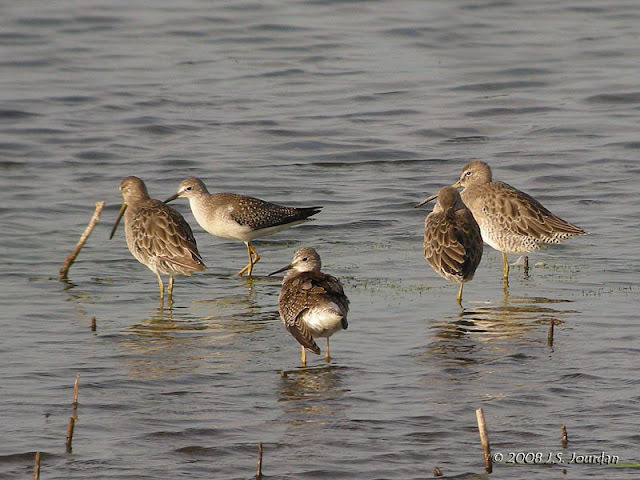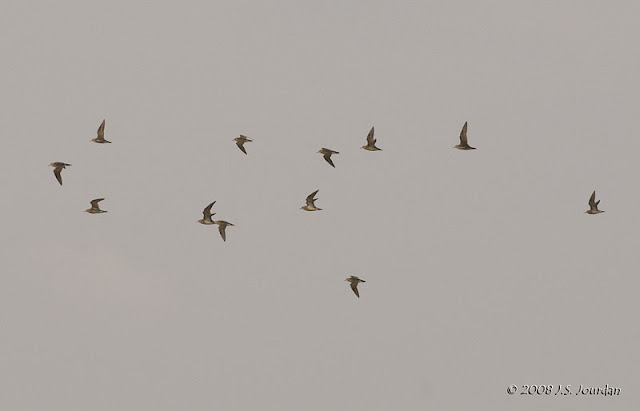15 Buff-breasted Sandpipers! - 14 Sep 2008
Yesterday, while Hurricane Ike hammered the Texas Gulf Coast, the Midwest got soaked with 1 - 6 inches of rain. Here in Wyandotte we got 3" of rain. Other locations north and west got up to 5" of rain. This afternoon Ike is supposed to bring a couple more inches of rain to us, but for now the skies are partly clear and its warm!
Driving past Mouillee Creek I noticed that no cars were in the parking lot. So I stopped and took the bike up the Middle Causeway. I couldn't help feel that I was experiencing March birding in September. It was warm, humid, windy, and the ground was extremely soft. Looking out over the marsh I saw and heard nothing while fighting both strong winds and soft mud. But reaching the Lead and Long Pond Units I began seeing fly-by Lesser Yellowlegs and a few Killdeer. As I reached the junction of Long Pond, Lead and Vermet Units I scoped a group of 6 Long-billed Dowitchers in basic plumage among another 4 - 6 Lesser Yellowlegs.
A pair of sleepy dowitchers provided a nice digiscoping opportunity, so I obliged.
Looking back toward the SE corner of the Long Pond Unit I found 4 Black-bellied Plovers in basic plumage feeding in the now-flooded field.
As I digiscoped a single bird I spotted a pair of American Pipits farther out in the field, and managed a few pics of one bird before everyone flew off to the west.
As I road east toward the Banana Unit I flushed a half-dozen Savannah Sparrows from the path ahead of me, but was unable to photograph them due to the severe backlighting. So I settled for scoping them to make sure nothing unusual was among them. Two dozen Great Egrets and a handfull of Caspian Terns were roosting in the Vermet Unit. A single Pied-billed Grebe swam near shore.
Reaching Cell 3 I spotted dozens of Green- and Blue-winged Teal roosting in the NW corner. They flushed as I arrived, leaving a half-dozen Lesser Yellowlegs. As I walked down the bank toward the shoreline, I was amazed at how much exposed shoreline existed. Despite all the rain yesterday Cell 3 looked exactly as dry as it did 2 weeks ago.
Semipalmated Sandpipers fed nearby,
along with several Pectoral Sandpipers,
Least Sandpipers, 3 Baird's Sandpipers, 2 Sanderlings, and a juvenile Ruddy Turnstone.
As I scoped farther out into the mudflats I spotted a pair of juvenile Red Knots and several White-rumped Sandpipers (although I find them extremely difficult to discern from the other peeps).
I spent a few minutes trying to digiscope a Baird's Sandpiper, Least Sandpiper and Semipalmated Sandpipers.
Satisfied that I wasn't missing anything unusual, I decided to head over to the east shoreline and scope the cell from the dike.
From the east dike I saw 4 Stilt Sandpipers in basic plumage. Another 6 juvenile Short-billed Dowitchers feed closer in, along with a pair of basic plumaged Dunlin, and another White-rumped Sandpiper. Farther inland another Ruddy Turnstone was seen.
Returning on the bike I rode into a flock a Buff-breasted Sandpipers that must've just flown in and landed next to the dirt piles in the SE corner of Cell 3. The birds flushed and flew just a short distance to the banks behind the sand piles. I approached slowly and managed to capture several shots as the BBSP's poked their heads out of the grass, and even flashed their wings a few times. At once the flock took to the air, and managed to count 12 individuals as they flew back and forth between Cells 3 and 4. I managed to capture a few flight shots before they headed out toward Cell 3, where they were joined by 3 additional birds. As they flew along the waterline I captured a couple long distance shots before the birds disappeared to the south. Wow!
Riding back down the Middle Causeway I saw a Northern Harrier (female) cruising the dike ahead of me, along with the Savannah Sparrows that I had seen earlier. Just before I reached the car I stopped twice to photograph a pair of baby Water Snakes that were sunning themselves in the road. I picked them up and moved them to the safety of the grass.
I returned to the car just as the rains from Ike approached.
Pte. Mouillee SGA (permit required Sep 1-Dec 15), Monroe, Michigan, US
Sep 14, 2008 7:00 AM - 10:00 AM
Protocol: Traveling
5.0 mile(s)
Checklist Comments: Duck hunting season officially starts tomorrow at Pt. Mouillee. From September 15 - December 31 the State Game Area will be closed to non-hunters. From a birder's standpoint I find it tragic, since I'm left wondering what I'm missing in terms of fall shorebirding. So, I took the chance this morning and headed down to Pt. Mouillee for one last chance to look for shorebirds.
Yesterday, while Hurricane Ike hammered the Texas Gulf Coast, the Midwest got soaked with 1 - 6 inches of rain. Here in Wyandotte we got 3" of rain. Other locations north and west got up to 5" of rain. This afternoon Ike is supposed to bring a couple more inches of rain to us, but for now the skies are partly clear and its warm!
24 species
Blue-winged Teal (Spatula discors) 12
Green-winged Teal (Anas crecca) 12
Pied-billed Grebe (Podilymbus podiceps) 1
Black-bellied Plover (Pluvialis squatarola) 4
Killdeer (Charadrius vociferus) 3
Short-billed Dowitcher (Limnodromus griseus) 6 scoped from east dike of Cell 3 among 4 Stilt Sandpipers. Juveniles with bright orange feathers, spotting on flanks. Lack the plumpness and basic plumage of LBDO
Long-billed Dowitcher (Limnodromus scolopaceus) 6 Note plump size and basic plumage. SBDO's do not molt until on wintering grounds.
Lesser Yellowlegs (Tringa flavipes) 13
Ruddy Turnstone (Arenaria interpres) 1
Red Knot (Calidris canutus) 2 juveniles; gray with white fringes that look like fish scales. straight bill, large shorebird.
Stilt Sandpiper (Calidris himantopus) 4
Buff-breasted Sandpiper (Calidris subruficollis) 15 Returning on the bike I rode into a flock a Buff-breasted Sandpipers that must've just flown in and landed next to the dirt piles in the SE corner of Cell 3.The birds flushed and flew just a short distance to the banks behind the sand piles. I approached slowly and managed to capture several shots as the BBSP's poked their heads out of the grass, and even flashed their wings a few times. At once the flock took to the air, and managed to count 12 individuals as they flew back and forth between Cells 3 and 4. I managed to capture a few flight shots before they headed out toward Cell 3, where they were joined by 3 additional birds. As they flew along the waterline I captured a couple long distance shots before the birds disappeared to the south. Wow!
Sanderling (Calidris alba) 2
Dunlin (Calidris alpina) 2 basic plumage; smoky gray with large, long, downcurved black bill and feet
Baird's Sandpiper (Calidris bairdii) 3
White-rumped Sandpiper (Calidris fuscicollis) 4
Least Sandpiper (Calidris minutilla) 1
Pectoral Sandpiper (Calidris melanotos) 3
Semipalmated Sandpiper (Calidris pusilla) 12
Caspian Tern (Hydroprogne caspia) 6
Great Egret (Ardea alba) 23
Northern Harrier (Circus hudsonius) 1
American Pipit (Anthus rubescens) 2
Savannah Sparrow (Passerculus sandwichensis) 6
View this checklist online at https://ebird.org/checklist/S4
This report was generated automatically by eBird v3 (https://ebird.org/home)
Sep 14, 2008 7:00 AM - 10:00 AM
Protocol: Traveling
5.0 mile(s)
Checklist Comments: Duck hunting season officially starts tomorrow at Pt. Mouillee. From September 15 - December 31 the State Game Area will be closed to non-hunters. From a birder's standpoint I find it tragic, since I'm left wondering what I'm missing in terms of fall shorebirding. So, I took the chance this morning and headed down to Pt. Mouillee for one last chance to look for shorebirds.
Yesterday, while Hurricane Ike hammered the Texas Gulf Coast, the Midwest got soaked with 1 - 6 inches of rain. Here in Wyandotte we got 3" of rain. Other locations north and west got up to 5" of rain. This afternoon Ike is supposed to bring a couple more inches of rain to us, but for now the skies are partly clear and its warm!
24 species
Blue-winged Teal (Spatula discors) 12
Green-winged Teal (Anas crecca) 12
Pied-billed Grebe (Podilymbus podiceps) 1
Black-bellied Plover (Pluvialis squatarola) 4
Killdeer (Charadrius vociferus) 3
Short-billed Dowitcher (Limnodromus griseus) 6 scoped from east dike of Cell 3 among 4 Stilt Sandpipers. Juveniles with bright orange feathers, spotting on flanks. Lack the plumpness and basic plumage of LBDO
Long-billed Dowitcher (Limnodromus scolopaceus) 6 Note plump size and basic plumage. SBDO's do not molt until on wintering grounds.
Lesser Yellowlegs (Tringa flavipes) 13
Ruddy Turnstone (Arenaria interpres) 1
Red Knot (Calidris canutus) 2 juveniles; gray with white fringes that look like fish scales. straight bill, large shorebird.
Stilt Sandpiper (Calidris himantopus) 4
Buff-breasted Sandpiper (Calidris subruficollis) 15 Returning on the bike I rode into a flock a Buff-breasted Sandpipers that must've just flown in and landed next to the dirt piles in the SE corner of Cell 3.The birds flushed and flew just a short distance to the banks behind the sand piles. I approached slowly and managed to capture several shots as the BBSP's poked their heads out of the grass, and even flashed their wings a few times. At once the flock took to the air, and managed to count 12 individuals as they flew back and forth between Cells 3 and 4. I managed to capture a few flight shots before they headed out toward Cell 3, where they were joined by 3 additional birds. As they flew along the waterline I captured a couple long distance shots before the birds disappeared to the south. Wow!
Sanderling (Calidris alba) 2
Dunlin (Calidris alpina) 2 basic plumage; smoky gray with large, long, downcurved black bill and feet
Baird's Sandpiper (Calidris bairdii) 3
White-rumped Sandpiper (Calidris fuscicollis) 4
Least Sandpiper (Calidris minutilla) 1
Pectoral Sandpiper (Calidris melanotos) 3
Semipalmated Sandpiper (Calidris pusilla) 12
Caspian Tern (Hydroprogne caspia) 6
Great Egret (Ardea alba) 23
Northern Harrier (Circus hudsonius) 1
American Pipit (Anthus rubescens) 2
Savannah Sparrow (Passerculus sandwichensis) 6
View this checklist online at https://ebird.org/checklist/S4
This report was generated automatically by eBird v3 (https://ebird.org/home)










































Hi Jerry,
ReplyDeleteGreat shots! Fifteen buffies is an amazing total - wonder if it could be a high count for the state?
Neil